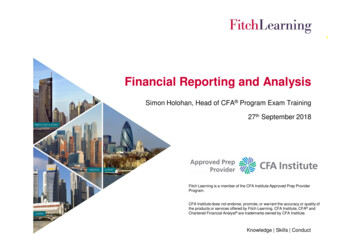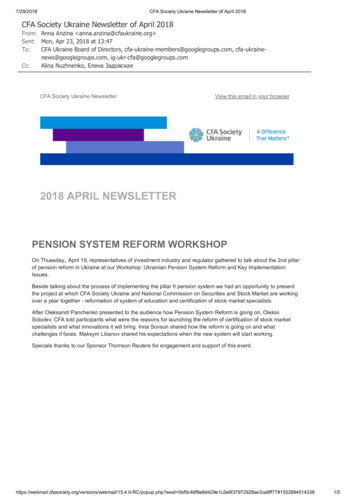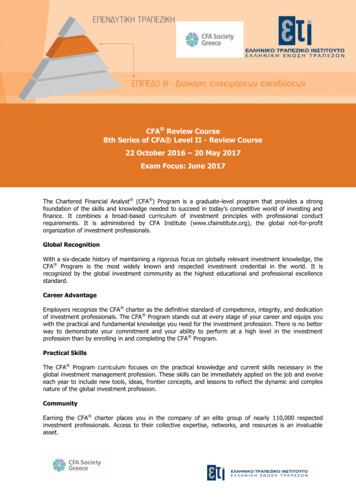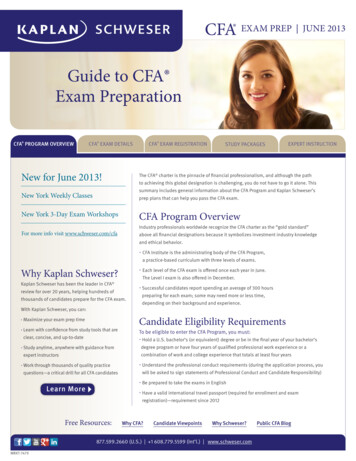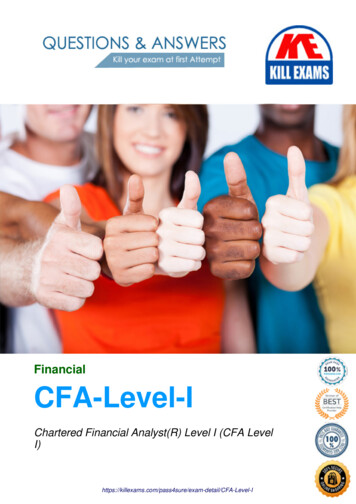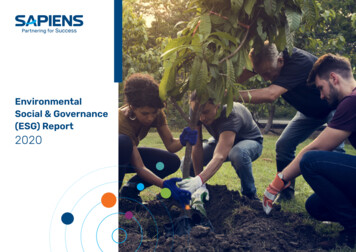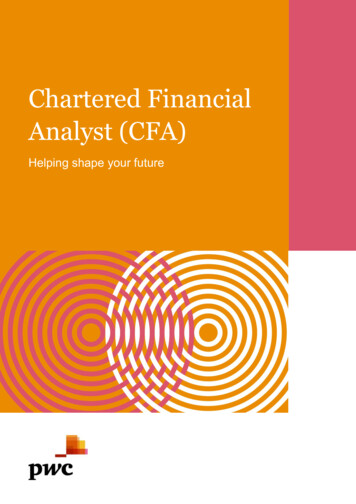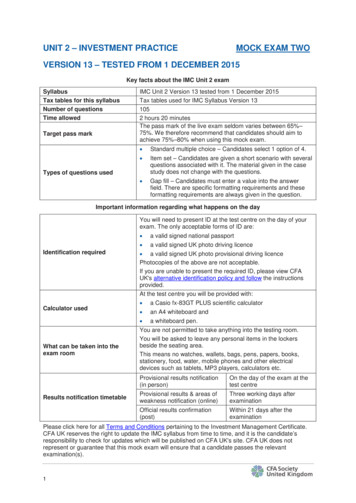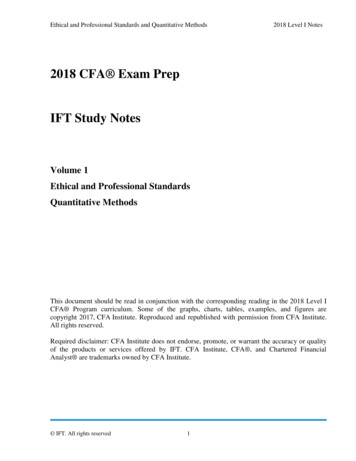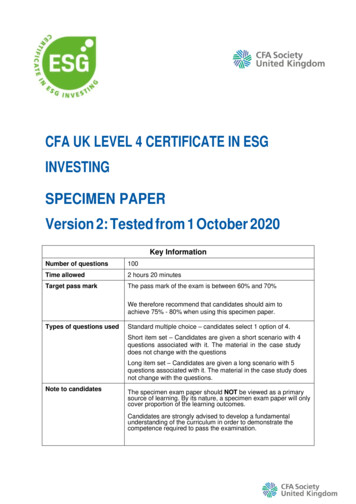
Transcription
CFA UK LEVEL 4 CERTIFICATE IN ESGINVESTINGSPECIMEN PAPERVersion 2: Tested from 1 October 2020Key InformationNumber of questions100Time allowed2 hours 20 minutesTarget pass markThe pass mark of the exam is between 60% and 70%We therefore recommend that candidates should aim toachieve 75% - 80% when using this specimen paper.Types of questions usedStandard multiple choice – candidates select 1 option of 4.Short item set – Candidates are given a short scenario with 4questions associated with it. The material in the case studydoes not change with the questionsLong item set – Candidates are given a long scenario with 5questions associated with it. The material in the case study doesnot change with the questions.Note to candidatesThe specimen exam paper should NOT be viewed as a primarysource of learning. By its nature, a specimen exam paper will onlycover proportion of the learning outcomes.Candidates are strongly advised to develop a fundamentalunderstanding of the curriculum in order to demonstrate thecompetence required to pass the examination.
Question allocation across the syllabus is balanced on the guidance of psychometric andindustry specialists. The following question allocation for Version 2 of the Certificate in ESGInvesting is provided as a broad indication of the relative ‘weighting’ of different parts of thesyllabus in examinations from 1 October 2020.TopicTopic NameQuestion Allocation1Introduction to ESG4-82The ESG Market4-83Environmental Factors6-124Social Factors6-125Governance Factors6-126Engagement and Stewardship6-107ESG Analysis, Valuation & Integration20-328ESG Integrated Portfolio Construction &Management8-149Investment Mandates, Portfolio Analytics &Client Reporting4-8CFA Society UK 2020 All rights reserved. CFA Society of the UK is a registered company inEngland with registration number 4035569. Please see our updated Terms and conditions
1.Research shows that companies with long standing good practice in terms of sustainabilityA.Outperform their peers in both accounting performance and stock markets returns.B.Underperform their peers in accounting performance and stock markets returns.C.Outperform their peers in accounting performance but underperform in stock market returns.D.Underperform their peers in accounting performance and outperforms in stock marketsreturns.2.Justin runs an equity fund for a large insurance company which has signed on to the UNGlobal Compact Principles and the Principles for Responsible Investment. His investmentstrategy will need to:i.avoid companies which do not adhere to Task Force on Climate-related FinancialDisclosures guidelinesii. screen the portfolio on environmental issuesiii. incorporate ESG issues into the investment processiv. invest in companies which adhere to human rights principlesA.iii.B.i and ii.C.ii and iii.D.iii and iv.3.Which UK body is responsible for issuing the Stewardship Code?A.The Financial Conduct Authority (FCA).B.The Financial Policy Committee (FPC).C.The Financial Ombudsman Service (FOS).D.The Financial Reporting Council (FRC).
4.A Sovereign Wealth Fund selecting an investment manager with an ESG strategy is likelyto focus more on the manager’s approach to:A.ESG engagement and stewardship.B.Integrating MSCI data while ESG scoring the portfolio.C.Liquidity of the portfolio and short-term performance.D.Quantitative analysis of portfolio attribution vs. the benchmark.5.Which of these least reflects how qualitative ESG data is used in company analysis?A.By adjusting a valuation.B.By adding an opinion to an investment thesis.C.By modifying a financial model.D.By determining the value at risk for the company.6.Adjusting the Discounted Cash Flow when integrating ESG into traditional financialanalysis is:A.Not valid at country level.B.Valid at the level of company, sector or country.C.Valid only at the level of specific company.D.Not valid at sector level.
7.Which action would be undertaken first by an investor wanting to follow an engagementstrategy with a company in a cost-effective way?A.Defining the scope of engagement and prioritising engagement activities.B.Developing a clear process which articulates realistic goals.C.Adapting the engagement process to the local context.D.Framing the engagement topic into a broader strategy discussion.8.Which comment best reflects the inclusion of 'bad actor' companies which have poorESG scores in ESG mutual funds?A.Bad actors are never included.B.Bad actors are rarely included.C.Bad actors are often included.D.Bad actors will always be included.9.A private wealth manager uses a data provider to screen out companies involved withtobacco and finds that the process eliminates nearly all consumer companies. Asconsumer companies are a large percentage of the benchmark index, the manager wouldprefer not to eliminate the whole sector.What method would be the most precise to reduce the number of companies which arescreened out?A.GICS 15 Screening regarding tobacco.B.ESG rating agency data regarding the financial materiality of tobacco.C.Percentage of company revenue related to tobacco as agreed with the client.D.Standard industry classification for tobacco companies.
10.What is an indirect environmental impact of a paper company cutting trees andtransporting them to its production plant?A.Carbon emissions from the haulage lorries.B.A natural regulator of carbon dioxide is destroyed,C.Deforestation.D.Local species are disturbed.11.Which approach is most likely to result in an analyst aggregating data into an ESGscore?A.Company specific research.B.Fundamental analysis.C.Stock picking.D.Quantitative modelling.12.What impact will a positive ESG rating have on a company's cost of capital?A.A lower cost of capital.B.No change to the cost of capital.C.A higher cost of capital.D.A more volatile cost of capital.
13.Which of the following sectors have the greatest risk of increased insurance costs due tophysical climate change?A.Construction and materials.B.Food and beverage.C.Media and technology.D.Travel and leisure.14.ABC Investment Management owns a 2% stake in a large telecom company, which is inthe media due to a surge in employee suicides attributed to pressures in the workplace.Mary, a senior analyst at ABC Investment Management, would like to engage with thecompany on the issue and sees that a quarterly earnings conference call is coming up.What should Mary do before the quarterly conference call?A.Arrange a pre-meeting call with the company's investor relations representative.B.Contact the Investor Forum.C.Establish clear objectives.D.Request a meeting with the chairman of the Board.15.Which of the following is not generally expected for companies which score well on ESGmetrics relative to companies scoring less well?A.They are better able to anticipate environmental change risks and opportunities.B.They enjoy valuation premiums due to changing investor concerns and preferences.C.They are more disposed to longer term strategic thinking and planning.D.They are more likely to grow rapidly and offer higher short term returns.
16.What is the result of an analyst failing to correctly model the risks and opportunitiesassociated with ESG?A.Systematic underestimation of high ESG performers and overestimation of ESG underperformers.B.Systematic overestimation of both high ESG performers and ESG under performers.C.Systematic underestimation of both high ESG performers and ESG under performers.D.Systematic overestimation of high ESG performers and underestimation of ESG underperformers.
17.Several questions are associated with the following case study. The material given in thecase study will not change.CBT’s Annual General Meeting (AGM) is two months away. Patrick Weeze is a portfoliomanager who owns a significant number of stocks of CBT in his portfolio. His fund is aconcentrated portfolio with high idiosyncratic risk and, as a result, he believes that adetailed analysis of the governance of each of his stocks is paramount to its long-termperformance. He reviews the relevant documentation regarding CBT’s AGM and notesthe following: CBT provides information on the total amount of CEO remuneration, but no detail on theKey Performance Indicators (KPIs) that influence variable compensation. The CEO’s totalcompensation last year was GBP 1.2 million, 30% of which was fixed salary. CBT currently has 10 individuals sitting on its board, 3 of whom are independent. TheChairman is the former CEO who stepped down last year. One of the resolutions to be voted at the AGM was put forward by a minority shareholder.The investor asks the company to produce a report on how climate change may affect thecompany’s strategy and financial stability in the long-term.Patrick is discussing CBT's financial model with his financial analyst. He asks the analystto consider how the model may take into account the KPIs for the CEO's variableremuneration which are not disclosed. He is presented with 4 options.Which one is he most likely to select to implement?A.Increase the company's estimated costs for next year by an additional GBP 1.2 millionto account for the lack of transparency regarding the KPIs.B.Reduce the company’s current total costs by GBP 360,000, as there are no concernsregarding the fixed salary portion of the compensation.C.Increase the cost of capital from 4.6% to 4.8% to reflect the increased risk stemmedfrom uncertainty around alignment of interest.D.Decrease the cost of capital from 4.6% to 4.4% to reflect the reduced level of certaintyaround alignment of interest.
18.Several questions are associated with the following case study. The material given in thecase study will not change.CBT's Annual General Meeting (AGM) is two months away. Patrick Weeze is a portfoliomanager who owns a significant number of stocks in CBT in his portfolio. His fund is aconcentrated portfolio with high idiosyncratic risk and, as a result, he believes that adetailed analysis of the governance of each of his stocks is paramount to its long-termperformance. He reviews the relevant documentation regarding CBT's AGM and notesthe following: CBT provides information on the total amount of CEO remuneration, but no detail on theKey Performance Indicators (KPIs) that influence variable compensation. The CEO’s totalcompensation last year was GBP 1.2 million, 30% of which was fixed salary. CBT currently has 10 individuals sitting on its board, 3 of whom are independent. TheChairman is the former CEO who stepped down last year. One of the resolutions to be voted at the AGM was put forward by a minority shareholder.The investor asks the company to produce a report on how climate change may affect thecompany’s strategy and financial stability in the long-term.Patrick believes that the Chair cannot be considered as an independent member of theboard. He schedules an engagement meeting with the Chair to discuss the matter.What could be the most favourable outcome from a governance perspective?A.The Chair steps down and the CEO assumes the chairmanship, and one of theindependent directors becomes the lead independent director.B.The Chair steps down and remains on the board, and one of the existing independentdirectors is elected Chair.C.An additional independent director is added to the board to increase the level ofindependence.D.The Chair steps down from the Board and the Chair role, and a newly-electedindependent director is appointed Chair.
19.Several questions are associated with the following case study. The material given in thecase study will not change.CBT's Annual General Meeting (AGM) is two months away. Patrick Weeze is a portfoliomanager who owns a significant number of stocks in CBT in his portfolio. His fund is aconcentrated portfolio with high idiosyncratic risk and, as a result, he believes that adetailed analysis of the governance of each of his stocks is paramount to its long-termperformance. He reviews the relevant documentation regarding CBT's AGM and notesthe following: CBT provides information on the total amount of CEO remuneration, but no detail on theKey Performance Indicators (KPIs) that influence variable compensation. The CEO’s totalcompensation last year was GBP 1.2 million, 30% of which was fixed salary. CBT currently has 10 individuals sitting on its board, 3 of whom are independent. TheChairman is the former CEO who stepped down last year. One of the resolutions to be voted at the AGM was put forward by a minority shareholder.The investor asks the company to produce a report on how climate change may affect thecompany’s strategy and financial stability in the long-term.When Patrick attempts to set up a call with CBT's Investor Relations to discussgovernance matters, they push back suggesting that these have no relevance to thecompany.
Which argument can Patrick use to best highlight the importance of appropriategovernance to enterprises?A.A meta study by Friede, Busch and Bassen has shown that the majority of studiesshowed a positive correlation between governance and corporate financialperformance.B.The CFA Institute's 2017 ESG survey showed that governance has the strongestcorrelation with company margin growth.C.Enron's case provides evidence that governance is simple and failures usually link toone single factor.D.Bernile, Bhagwat and Yonker's 2017 study concludes that board diversity adds togovernance complexity, thus destroying company value.
20.Several questions are associated with the following case study. The material given in thecase study will not change.CBT's Annual General Meeting (AGM) is two months away. Patrick Weeze is a portfoliomanager who owns a significant number of stocks in CBT in his portfolio. His fund is aconcentrated portfolio with high idiosyncratic risk and, as a result, he believes that adetailed analysis of the governance of each of his stocks is paramount to its long-termperformance. He reviews the relevant documentation regarding CBT's AGM and notesthe following: CBT provides information on the total amount of CEO remuneration, but no detail on theKey Performance Indicators (KPIs) that influence variable compensation. The CEO’s totalcompensation last year was GBP 1.2 million, 30% of which was fixed salary. CBT currently has 10 individuals sitting at its board, 3 of whom are independent. TheChairman is the former CEO who stepped down last year. One of the resolutions to be voted at the AGM was put forward by a minority shareholder.The investor asks the company to produce a report on how climate change may affect thecompany’s strategy and financial stability in the long-term.What is Patrick least likely to take into consideration when making a decision regardinghis vote on the shareholder resolution?A.The extent to which the company and its business model is exposed to climatechange risks.B.Whether, and to what extent, the company already provides information on the topic ofclimate change risk.C.The company's response on whether it supports the resolution and why.D.Whether this resolution falls under the category of governance.
21.What do corporate governance structures in France and the US have in common?A.Chief Executive and Chairman of the Board are typically one person.B.National corporate governance codes.C.Statutory auditors in addition to independent auditors.D.Two-tier boards.22.Which of the following is an example of climate change mitigation?A.Building a flood defence.B.Developing drought resistant crop.C.Retrofitting a building.D.Desalinating water.23.Sienna reviews a large retailer faced with a sex equality law suit with a potential 4 billionin pay out claims. How should she adjust her financial model?A.Adjust the employee expense line to reflect 4 billion in pay out over 10 years.B.Do nothing as the company has a good case and may not have to pay.C.Lower the discount rate to reflect the risk of pay outs.D.Raise the cost of capital to reflect the risk of pay outs.
24.Which of these statements best describes responsible investing?A.Targeted investment returns with certain investments being negatively screened.B.ESG factors taken into account to mitigate risk with a focus on financial return.C.Investments made in a way that captures returns while achieving an intentional effect.D.ESG factors taking into account to mitigate risk with a focus on capturing ESG opportunities.25.Bill is a philanthropist who is approached by four charitable organisations that each claimto have a solution that reduces mortality by 15% in their specific area of focus if theyreceive 300 million. Bill's aim is to reduce mortality rates as much as possible. Whichone of the following charities should he choose?A.A charity focussing on drought.B.A charity focussing on malaria.C.A charity focussing on pollution.D.A charity focussing on violence.26.How can climate-related scenario analysis be used as an effective tool in portfoliomanagement?i.By pricing climate risk.ii.By assessing the portfolio's alignment with the Paris Agreement temperature target.iii.By bottom-up analysis of individual companies in the portfolio.iv.By producing standardised data for performance measurement.A.iB.i and iiC.i, ii and iiiD.i, ii, iii and iv
27.Several questions are associated with the following case study. The material given in thecase study will not change.Daniel Stinner was asked by the head of Research at Lopse Ratings to propose amethodology to rate sovereigns. Lopse Ratings is a well regarded rating agency, but ithas been falling behind its peers because, whilst it has integrated ESG within corporateissuers, it has not yet integrated ESG within sovereign issuers.After a few months of research in the industry and within Lopse, Daniel proposed thefollowing to the Head of Research:E, S and G weights to a final ESG score reflect the extent that the individual factor is adriver from a credit perspective.Scores range from factors that individually are adequately managed or contributing to thesovereign’s financial capacity (5) to those which may impose a significant strain onfinancial streams (1). They do not make value judgments on whether a sovereignengages in 'good' or 'bad' ESG practices. Instead, they draw out how E, S and G factorsare influencing the credit rating decision.Political risk, rule of law and corruption have been key drivers of rating actions in the past,indicating that governance was already playing a role in the rating model. It should bemade explicit that these are governance-related matters, and thus considered as the ‘G’within ESG. No other governance issue was deemed material across all types ofsovereigns. Data could be gathered from the World Bank's Governance Indicators(WBGI) and Transparency International.Social factors also have an important influence on sovereign ratings. Certain factors arerelated to government’s accountability, while others impact the longer-term productivity,and thus growth (plus indirectly, taxing capability) of the country. These factors areconsidered as the ‘S’ within ESG. Environmental risks, the ‘E’ within ESG, were identifiedas more idiosyncratic to each country based on their location and dependency.
The weighted average of the factors within each of the E, S and G pillars provide thescore for that pillar, and the weighted average of the pillars provide the final ESG scorefor the sovereign issuer.Daniel provided examples of the rating system applied to two different sovereigns, asdetailed below.In order to provide his boss with greater context of the ESG rating for each of thecountries, Daniel briefly describes a few characteristics of each.
Which of the below are most likely part of the description for each company?A.1B.2C.3D.4
28.Several questions are associated with the following case study. The material given in thecase study will not change.Daniel Stinner was asked by the head of Research at Lopse Ratings to propose amethodology to rate sovereigns. Lopse Ratings is a well regarded rating agency, but ithas been falling behind its peers because, whilst it has integrated ESG within corporateissuers, it has not yet integrated ESG within sovereign issuers.After a few months of research in the industry and within Lopse, Daniel proposed thefollowing to the Head of Research:E, S and G weights assigned to a final ESG score reflect the extent that the individualfactor is a driver from a credit perspective.Scores range from factors that are individually adequately managed or contribute to thesovereign’s financial capacity (highest, 5) to those, which may impose a significant strainon financial streams (lowest, 1). They do not make value judgments on whether asovereign engages in 'good' or 'bad' ESG practices. Instead, they draw out how E, S andG factors are influencing the credit rating decision.Political risk, rule of law and corruption have been key drivers of rating actions in the past,indicating that governance already played a role in the rating model. It should be madeexplicit that these are governance-related matters, and thus considered as the ‘G’ withinESG. No other governance issue was deemed material across all types of sovereigns.Data could be gathered from the World Bank's Governance Indicators (WBGI) andTransparency International.Social factors also have an important influence on sovereign ratings. Certain factors arerelated to government’s accountability, while others impact the longer-term productivity,and thus growth (plus indirectly, taxing capability) of the country. These factors areconsidered as the ‘S’ within ESG. Environmental risks, the ‘E’ within ESG, were identifiedas more idiosyncratic to each country based on their location and dependency.Weighted average of the factors within each of the E, S and G pillars provide the score forthat pillar, and the weighted average of the pillars provide the final ESG score for thesovereign issuer.
Daniel provided examples of the rating system applied to two different sovereigns, asdetailed below.What might be a reasonable distribution of weight among each of the E, S and G pillars?A.E 33.3%, S 33.3%, G 33.3%B.E 33.3%, S 44.4%, G 22.2%C.E 40%, S 40%, G 20%D.E 20%, S 30%, G 50%
29.Several questions are associated with the following case study. The material given in thecase study will not change.Daniel Stinner was asked by the head of Research at Lopse Ratings to propose amethodology to rate sovereigns. Lopse Ratings is a well regarded rating agency, but ithas been falling behind its peers because, whilst it has integrated ESG within corporateissuers, it has not yet integrated ESG within sovereign issuers.After a few months of research in the industry and within Lopse, Daniel proposed thefollowing to the Head of Research:E, S and G weights to a final ESG score reflect the extent that the individual factor is adriver from a credit perspective. Scores range from factors that individually are adequatelymanaged or contributing to the sovereign’s financial capacity (5) to those which mayimpose a significant strain on financial streams (1). They do not make value judgments onwhether a sovereign engages in 'good' or 'bad' ESG practices. Instead, they draw out howE, S and G factors are influencing the credit rating decision.Political risk, rule of law and corruption have been key drivers of rating actions in the past,indicating that governance was already playing a role in the rating model. It should bemade explicit that these are governance-related matters, and thus considered as the ‘G’within ESG. No other governance issue was deemed material across all types ofsovereigns. Data could be gathered from the World Bank's Governance Indicators(WBGI) and Transparency International.Social factors also have an important influence on sovereign ratings. Certain factors arerelated to government’s accountability, while others impact the longer-term productivity,and thus growth (plus indirectly, taxing capability) of the country. These factors areconsidered as the ‘S’ within ESG. Environmental risks, the ‘E’ within ESG, were identifiedas more idiosyncratic to each country based on their location and dependency.Weighted average of the factors within each of the E, S and G pillars provide the score forthat pillar, and the weighted average of the pillars provide the final ESG score for thesovereign issuer.
Daniel provided examples of the rating system applied to two different sovereigns, asdetailed below.What might explain a downward trend in Country B’s water score?A.Rising sea levels close to industrial zones.B.Increased drought in agricultural areas.C.Reduced access of low-income populations to water and sanitation.D.Increased river discharge due to longer rainy season.
30.Several questions are associated with the following case study. The material given in thecase study will not change.Daniel Stinner was asked by the head of Research at Lopse Ratings to propose amethodology to rate sovereigns. Lopse Ratings is a well regarded rating agency, but ithas been falling behind its peers because, whilst it has integrated ESG within corporateissuers, it has not yet integrated ESG within sovereign issuers.After a few months of research in the industry and within Lopse, Daniel proposed thefollowing to the Head of Research:E, S and G weights to a final ESG score reflect the extent that the individual factor is adriver from a credit perspective. Scores range from factors that individually are adequatelymanaged or contributing to the sovereign’s financial capacity (5) to those which mayimpose a significant strain on financial streams (1). They do not make value judgments onwhether a sovereign engages in 'good' or 'bad' ESG practices. Instead, they draw out howE, S and G factors are influencing the credit rating decision.Political risk, rule of law and corruption have been key drivers of rating actions in the past,indicating that governance was already playing a role in the rating model. It should bemade explicit that these are governance-related matters, and thus considered as the ‘G’within ESG. No other governance issue was deemed material across all types ofsovereigns. Data could be gathered from the World Bank's Governance Indicators(WBGI) and Transparency International.Social factors also have an important influence on sovereign ratings. Certain factors arerelated to government’s accountability, while others impact the longer-term productivity,and thus growth (plus indirectly, taxing capability) of the country. These factors areconsidered as the ‘S’ within ESG. Environmental risks, the ‘E’ within ESG, were identifiedas more idiosyncratic to each country based on their location and dependency.Weighted average of the factors within each of the E, S and G pillars provide the score forthat pillar, and the weighted average of the pillars provide the final ESG score for thesovereign issuer.
Daniel provided examples of the rating system applied to two different sovereigns, asdetailed below.How might Country A improve its score for Climate Resilience in the short to medium-term?A.Improve adaptation methods.B.Improve mitigation methods.C.Reduce the number of stranded assets.D.Align itself with the Paris Agreement.
31.Several questions are associated with the following case study. The material given in thecase study will not change.Daniel Stinner was asked by the head of Research at Lopse Ratings to propose amethodology to rate sovereigns. Lopse Ratings is a well regarded rating agency, but ithas been falling behind its peers because, whilst it has integrated ESG within corporateissuers, it has not yet integrated ESG within sovereign issuers.After a few months of research in the industry and within Lopse, Daniel proposed thefollowing to the Head of Research:E, S and G weights to a final ESG score reflect the extent that the individual factor is adriver from a credit perspective. Scores range from factors that individually are adequatelymanaged or contributing to the sovereign’s financial capacity (5) to those which mayimpose a significant strain on financial streams (1). They do not make value judgments onwhether a sovereign engages in 'good' or 'bad' ESG practices. Instead, they draw out howE, S and G factors are influencing the credit rating decision.Political risk, rule of law and corruption have been key drivers of rating actions in the past,indicating that governance was already playing a role in the rating model. It should bemade explicit that these are governance-related matters, and thus considered as the ‘G’within ESG. No other governance issue was deemed material across all types ofsovereigns. Data could be gathered from the World Bank's Governance Indicators(WBGI) and Transparency International.Social factors also have an important influence on sovereign ratings. Certain factors arerelated to government’s accountability, while others impact the longer-term productivity,and thus growth (plus indirectly, taxing capability) of the country. These factors areconsidered as the ‘S’ within ESG. Environmental risks, the ‘E’ within ESG, were identifiedas more idiosyncratic to each country based on their location and dependency.Weighted average of the factors within each of the E, S and G pillars provide the score forthat pillar, and the weighted average of the pillars provide the final ESG score for thesovereign issuer.
Daniel provided examples of the rating system applied to two different sovereigns, asdetailed below.What might explain the different trends Country A and Country B are experiencing withregards to demographics?A.In developed markets, such as Country A, the ratio between active and inactive part ofthe workforce drops.B.In developed markets, such as Country B, the ratio between active and inactive part ofthe workforce rises.C.In developing markets, such as Country B, the ratio between active and inactive partof the workforce drops.D.In developing markets, such as Country A, the ratio between active and inactive partof the workfo
CFA UK LEVEL 4 CERTIFICATE IN ESG INVESTING SPECIMEN PAPER Version 2: Tested from 1 October 2020 Key Information Number of questions 100 Time allowed 2 hours 20 minutes Target pass mark The pass mark of the exam is between 60% and 70% We therefore recommend that candidates should

